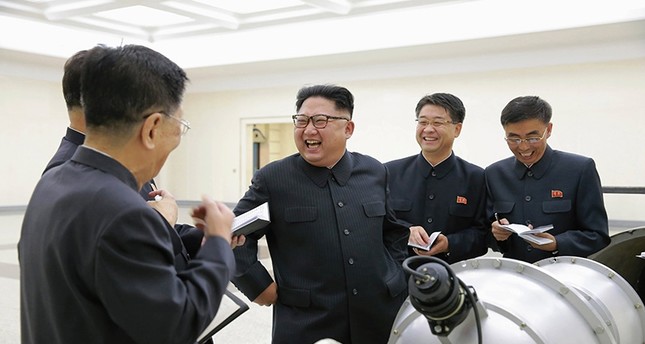North Korea not demonstrated all components of ICBM, US general says
North Korea has made new advances in its intercontinental ballistic missile program but has not yet demonstrated all the capabilities needed to strike America with such a weapon, a top U.S. general said Tuesday.
 An undated photo released by the North Korean Central News Agency (KCNA) on 03 September 2017 shows Kim Jong-un purportedly guiding the work for nuclear weaponization on spot, at an undisclosed location, North Korea. (EPA Photo)
An undated photo released by the North Korean Central News Agency (KCNA) on 03 September 2017 shows Kim Jong-un purportedly guiding the work for nuclear weaponization on spot, at an undisclosed location, North Korea. (EPA Photo)An undated photo released by the North Korean Central News Agency (KCNA) on 03 September 2017 shows Kim Jong-un purportedly guiding the work for nuclear weaponization on spot, at an undisclosed location, North Korea. (EPA Photo)
While Pyongyang has shown it can put the United States in range and point a rocket to the country, General Paul Selva, vice chairman of the Joint Chiefs of Staff, said it has not yet proven that its fusing and targeting technologies can survive the stresses of ballistic missile flight.
“They have made some strides but it’s still true that they haven’t demonstrated all of the components of an intercontinental ballistic missile system,” Selva told reporters.
Also unclear is whether North Korea has a re-entry vehicle strong enough to return into the Earth’s atmosphere from space and deliver a warhead.
“It’s possible (North Korean leader Kim Jong-Un) has them, so we have to place the bet that he might have them, but he hasn’t demonstrated them,” Selva said.
In November, North Korea said it had successfully tested a new type of ICBM that could reach all of the U.S. mainland and South Korea. U.S.-based experts said data from the test appeared to support that.
Selva said that if conflict were to break out, it was unlikely the United States would be able to get an early indication of North Korean launches.
“It is very unlikely that in a tactical situation, we would get any of the indications and warning that would precede a launch other than if we got lucky and saw the movement of the launch mechanism to the launch platform,” Selva said.
He added that by using mobile erected launchers, the warning time for the United States had decreased from up to an hour to about a dozen minutes.
The Trump administration has said all options are on the table in dealing with North Korea, but debate on military options has lost some momentum in recent weeks after North and South Korea resumed talks ahead of next month’s Winter Olympics in the South.
Selva said the Pentagon’s upcoming nuclear posture review, expected to be released on Friday, would lay out the future of nuclear modernization and may include new missiles on submarines.
A leaked draft policy document posted online this month, said the United States would pursue development of a new nuclear-armed sea-launched cruise missile.
Source:dailysabah.com
